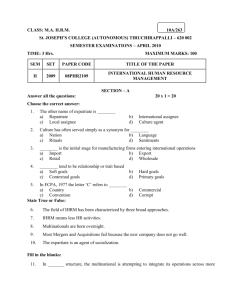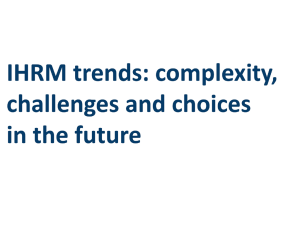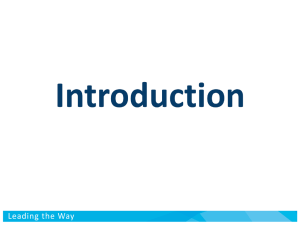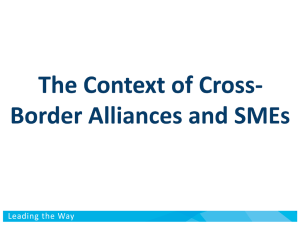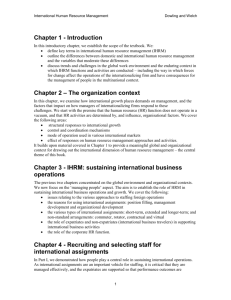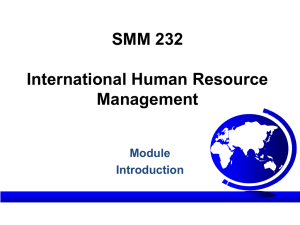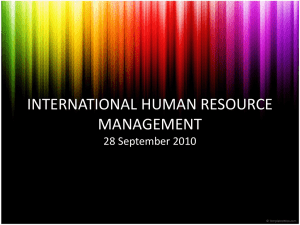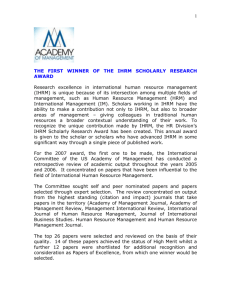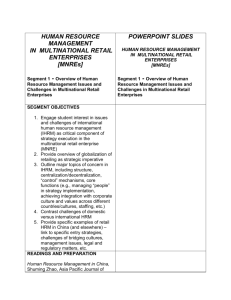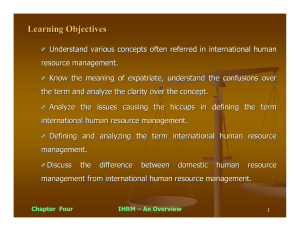International Human Resource Management (IHRM) Chapter – 2
advertisement
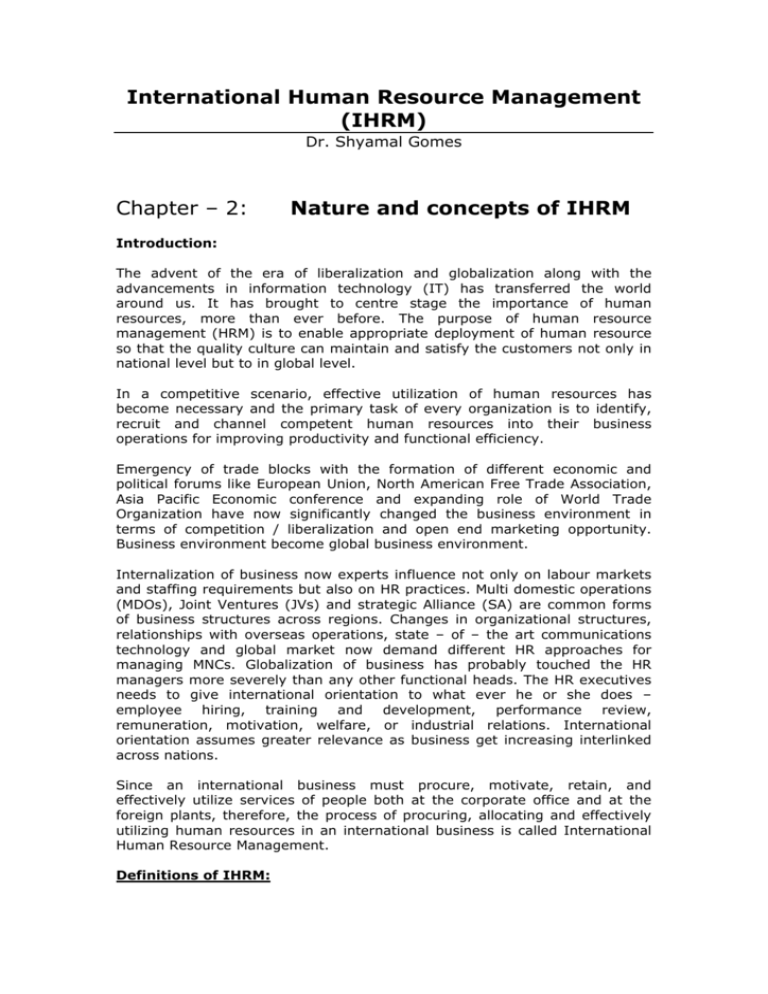
International Human Resource Management (IHRM) Dr. Shyamal Gomes Chapter – 2: Nature and concepts of IHRM Introduction: The advent of the era of liberalization and globalization along with the advancements in information technology (IT) has transferred the world around us. It has brought to centre stage the importance of human resources, more than ever before. The purpose of human resource management (HRM) is to enable appropriate deployment of human resource so that the quality culture can maintain and satisfy the customers not only in national level but to in global level. In a competitive scenario, effective utilization of human resources has become necessary and the primary task of every organization is to identify, recruit and channel competent human resources into their business operations for improving productivity and functional efficiency. Emergency of trade blocks with the formation of different economic and political forums like European Union, North American Free Trade Association, Asia Pacific Economic conference and expanding role of World Trade Organization have now significantly changed the business environment in terms of competition / liberalization and open end marketing opportunity. Business environment become global business environment. Internalization of business now experts influence not only on labour markets and staffing requirements but also on HR practices. Multi domestic operations (MDOs), Joint Ventures (JVs) and strategic Alliance (SA) are common forms of business structures across regions. Changes in organizational structures, relationships with overseas operations, state – of – the art communications technology and global market now demand different HR approaches for managing MNCs. Globalization of business has probably touched the HR managers more severely than any other functional heads. The HR executives needs to give international orientation to what ever he or she does – employee hiring, training and development, performance review, remuneration, motivation, welfare, or industrial relations. International orientation assumes greater relevance as business get increasing interlinked across nations. Since an international business must procure, motivate, retain, and effectively utilize services of people both at the corporate office and at the foreign plants, therefore, the process of procuring, allocating and effectively utilizing human resources in an international business is called International Human Resource Management. Definitions of IHRM: International human resource management is all about the world wide management of human resources – Process of sourcing, allocating, and effectively utilising their skill, knowledge, ideas, plan and perspective in responding to TQM. The process of procuring, allocating and effectively utilizing human resources in an international business is called International Human Resource Management or IHRM. International Human Resource Management is the process of sourcing, allocating and effectively utilizing human resources in a multinational organization. Dimensions of IHRM: According to P.V. Morgan: IHRM is the interplay among 3 dimensions: HR Activities Types of employees Types of Countries Dimension Model of IHRM. (Source: ad opting from P.V.Morgan, IHRM : Fact or Fiction. Personnel Administrator, Vol 31, 9 (1986) pp 44) 1) Broad activities of IHRM – procurement, allocation and utilization of human resources cover all the six activities of domestics HRM i.e, HR planning, Employees Hiring, Training and Development, Remuneration, Performance Management and Industrial Relations. 2) The three national or country categories involved in IHRM activities are: - The host country where subsidiary may be located - The home country where the company has its head quarters and - Other countries that may be sources of labour or finance. 3) The three types of employees of an international business are – Parent Country Nationals (PCNs) , Host Country Nationals (HCNs) and Third Country Nationals (TCNs). For example, IBM which employs Australian citizens in its Australian operations, after sends US citizens to Asia Pacific countries on assignment, and may send some of its Singaporean employees to its Japanese operations. Purpose of IHRM: To enable the firm /, the multinational corporations (MNCs), to be a successful globally. Objectives of IHRM: • • • • • Remaining competitive throughout the world Efficient Locally Responsive Flexible and adaptive Capable to transforming learning across their globally dispersed units Difference Between domestic and IHRM: One obvious difference between domestic and international HRM is that staff are moved across the national boundaries into various roles within the international firm’s foreign operations – these employees have traditionally been called ‘expatriate’. An expatriate is an employee who is working temporarily residing in a foreign country. However, as pointed out by Dowling (1999) domestic HRM is involved with employees within only one national boundary; on the other hand IHRM deals with 3 nationals or country categories (expatriate): PCN, HCN and TCN. So, broadly there are two major factors therefore which differentiate domestic HRM from IHRM. 1. The complexities of operating in different countries / cultures 2. Employing different nationals and different categories of workers across boarder. It has been also argued by Dowling (1999) that the complexities of IHRM can be attributed to six factors that differentiate international from domestic HRM. Theses are: 1. A wide range of HR activities 1) The need for a broader perspectives 2) More Involvement in employee’s personal life. 3) Responsiveness to changes in staffing requirements as international strategy changes. 4) Higher risk exposure 5) More external influences. However, the international dimension brings with it a host of issues, which the domestic HR functions would not normally get involved in. The practice of HRM in the international context is different from its domestic counterpart in a number of ways. These include: 1. Being responsible for a greater number of functions and activities such as selection, training and management of international assignees. 2. Having to expand one’s area of expertise to include a much broader knowledge of foreign country employment laws and global organization designs. 3. Having to get much more closely involved with employees lives as the firm moves employees to foreign assignments. For example, collecting information and furnishing to visa authorities about aids or material status of employees. 4. Being involved with greatly expanded and constantly changing mix of employees (from the host countries and foreign locals), adding considerable diversity and complexity to the HR tasks. 5. Having no cope with more external influences; for example, having to consider the impact of foreign cultures and laws. 6. Having to face greater exposure to problems and liabilities (for example, making mistakes in expatriate assignments can cost as much as US$4 million per assignee). The accumulated direct and indirect costs can be huge. 7. Additional responsibilities like translation of language, both at headquarters and at the subsidiary level, organizing schooling and housing for expatriates and providing administrative services. 8. Management of differential compensation due to variety of allowances and adjustments. 9. More emphasis on activities like international relocation and orientation, both pre departure and post departure cultural training. Knowledge of international taxation, rate of inflation and cost of living, including currency fluctuation. 10. Diversity management, like managing people from different cultural and political backgrounds and gender differences. 11. More contacts with Government officials for obtaining visas, work permits, tax certificates, fixing of meetings and so on. 12. More coordination and travel to assess performance of expatriates and solve problems. 13. More risk management as threats from terrorists, Kidnappers and protecting intellectual property rights of firms. 14. More risk management as threats from terrorists, kidnappers and protecting intellectual property rights of firms. 15. More public relations work to enhance the multinationals image and deal with human rights and other NGOs and interest group operating in different countries. How International assignments create an Expatriate? TCNs TCNs Other countries Nationals Here we have to remember that IHRM Department is purely heterogeneous in nature because it deals the diverse cultures i.e. amalgamation of Global Workforce. (PCN, HCN and TCN). What types of people required where or which unit it is depends on the following points: • Availability of useful human resources • Economic Justification / cost effectiveness • Employee motivation and performance • Global exposure for need of the organization • Development of Cross cultural Management • Brand Loyalty or International fame. Significance of IHRM in International Business: Scullion (2001) outlined 10 major significance of IHRM in globally business environment. This significance can categorised in 5 key areas: Challenge Congruence Competence Signific ance of Commitment Cost Effectiveness CHALLENGE: Rapid growth of internalization and global competition has increased the nos. and significances of MNCs – resulting in the increased mobility of human resources. Increasing no. of strategic alliances and cross border mergers and acquisitions has increased the strategic implementation of IHRM as Global business. COMMITMENT: 1. World wide recognition of management of human resources in international business and cross cultural management. 2. Business Networks and Horizontal communication and HR plays a vital role. COST EFFECIVENESS: The performance of expatriates. (poor performance of expatriate may affect the market share and damage to foreign relations) Growing Importance of Expatriates in International Business. COMPETENCE: Global Strategy Implementation. Success or failure of international business based on effectiveness of management of HR. CONGRUENCE: Learning, knowledge acquisitions have been identified as important potential sources of comp. advantages for MNCs. This has also enhanced the role of IHRM to meet the key strategic challenge of objectives. Knowledge management is an important source of comp. advantage for MNCs, where IHRM is the key partner and plays a central role. Major Issues in International HRM: According to Hendry (1994), there are three main Issues in IHRM: 1. The management and development of expatriates- selection, training, compensation and repatriation of expatriate failures. 2. The internationalization of management through out the organization (host country, parent country and other third countries) 3. The need to internationalize the whole organization by creating a new corporate culture reflecting the need for greater international experiences across the whole organization, due to the increasing frequency of cross cultural interactions of doing business at home as well as abroad mainly Cultural communication & gauge and Language and communication Role of International HRM: International human resource management is the basis of success of any global multinational organization. International HRM enhances employee’s effectiveness to achieve goals of the organization and meet the needs; to develop employees to assume more diverse tasks, assignments, face challenging situations and better understand the cultural variations across the nations. IHRM department deals with heterogeneous functions and has to give additional focus on various aspects, such as: 1. More involvement in the employee’s personal life. 2. Deal with different groups of employees i.e. PCN, HCN and TCN for which HR policies and practices may differ. International HR managers have to understand cultural differentiation in multicultural environment. 3. Manage external influences, i.e host government authorities, business and other interest pressure and labour groups, etc. 4. Lay different emphasis on management training to deal diverse workforce, their orientation and to meet international environment and 5. Provide guidance on taxation and compensation aspects. However, there are some important limitations in IHRM: Management is basically the principle based on local cultures, traditions, practices and needs of the organizational growth. It is not universal for everywhere, specially in the field of human resources management. HRM methods and systems developed by one society can not always be transferred and applied to another. HRM and industrial relations practices differ across countries as these have their historic origin in countries. Personnel management and industrial relations are embedded in societal rules, norms, values, ideologies and no MNC can afford to ignore the influence of local culture. Conclusion: Thus it has been observed that effective internationalization of human resources management and IRs remains bleak. The degree of adaptation on International HRM to local customs in various subsidiaries of MNCs will be remaining on the strategic agenda. and managing International HR activities is an elaborate and complex task for to day’s manager. Thanks Dr. Shyamal Gomes Shyam_gomes@yahoo.com
